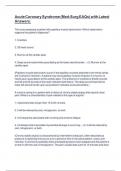Acute Coronary Syndrome (Med-Surg EAQs) with Latest
Answers.
The nurse assesses a patient with papillary muscle dysfunction. Which observation
supports the patient's diagnosis?
1. Crackles
2. S3 heart sound
3. Murmur at the cardiac apex
4. Deep sound noted while auscultating at the lower sternal border. - >3. Murmur at the
cardiac apex
(Papillary muscle dysfunction occurs if the papillary muscles attached to the mitral valves
are involved in infarction. A patient may have papillary muscle infraction if a murmur is
heard upon auscultation at the cardiac apex. The presence of crackles of breath sounds
and S3 and S4 sounds of the heart indicate heart failure. The deep sound heard at the
lower left sternal border upon auscultation indicates acute pericarditis.)
A nurse is caring for a patient with a history of chronic stable angina that reports chest
pain. What is a characteristic of pain related to this type of angina?
1. It generally lasts longer than 15 to 20 minutes.
2. It will be relieved by rest, nitroglycerin, or both.
3. It is frequently associated with vomiting and extreme fatigue.
4. It indicates that irreversible myocardial damage is occurring. - >2. It will be relieved by
rest, nitroglycerin, or both.
(Chronic stable angina is characterized by intermittent chest pain, often described as
pressure or tightness that occurs over a period of time in the same pattern, onset, and
intensity. It commonly subsides when precipitating factors have stopped and the patient is
at rest or with the use of nitroglycerin. The pain usually lasts just 5 to 15 minutes and does
,not always indicate irreversible myocardial damage. Vomiting and extreme fatigue are
symptoms of myocardial infarction and are not commonly seen in chronic stable angina.)
A patient that is being discharged from the hospital after acute coronary syndrome will be
participating in cardiac rehabilitation. What information should the nurse provide about the
early recovery phase of rehabilitation?
1. Therapeutic lifestyle changes should become lifelong habits.
2. Physical activity always begins in the hospital and continued at home.
3. Activity level is increased gradually with supervision by the rehabilitation team and with
ECG monitoring.
4. The focus of rehabilitation will be on management of chest pain, anxiety, dysrhythmias,
and other complications. - >3. Activity level is increased gradually with supervision by the
rehabilitation team and with ECG monitoring.
(In the early recovery phase after the patient is dismissed from the hospital, the activity
level is increased gradually under supervision and with ECG monitoring. The late
recovery phase includes therapeutic lifestyle changes that become lifelong habits. In the
first phase of recovery, activity is dependent on the severity of the angina or myocardial
infarction (MI), and attention is focused on the management of chest pain, anxiety,
dysrhythmias, and other complications. With early recovery phase, the cardiac
rehabilitation team may suggest that physical activity be initiated at home, but this is not
always done.)
When planning emergent care for a patient with a suspected myocardial infarction (MI),
what should the nurse anticipate administrating?
1. Oxygen, nitroglycerin, aspirin, and morphine
2. Aspirin, nitroprusside, dopamine, and oxygen
3. Nitroglycerine, lorazepam, oxygen, and warfarin
4. Oxygen, furosemide, nitroglycerin, and meperidine - >1. Oxygen, nitroglycerin, aspirin,
and morphine
, (The American Heart Association's guidelines for emergency care of the patient with chest
pain include the administration of oxygen, nitroglycerin, aspirin, and morphine. These
interventions serve to relieve chest pain, improve oxygenation, decrease myocardial
workload, and prevent further platelet aggregation. Furosemide, meperidine,
nitroprusside, dopamine, lorazepam, and warfarin may be used later in the patient's
treatment.)
The nurse is caring for a patient with a myocardial infarction. The health care provider
prescribes an intravenous infusion of alteplase. What is the priority nursing intervention
during the administration of this medication?
1. Assess neurologic status
2. Observe for bleeding gums
3. Monitor blood pressure for orthostatic changes
4. Apply a pressure dressing to IV insertion site - >1. Assess neurologic status
(Assessment for changes in neurologic status is the priority nursing intervention because
this may indicate a cerebral bleed. Gingival or bleeding gums are expected with
thrombolytic therapy and are controlled by applying ice packs. Application of a pressure
dressing to the IV insertion site is not done until evidence of bleeding is noted. Monitoring
blood pressure for orthostatic changes is necessary with the use of short-acting nitrates.)
During the 48 hours after a myocardial infarction (MI), a nurse should assign the highest
priority to monitoring the patient for what complication?
1. Dysrhythmias
2. Anxiety and fear
3. Metabolic acidosis
4. Medication side effects - >1. Dysrhythmias




